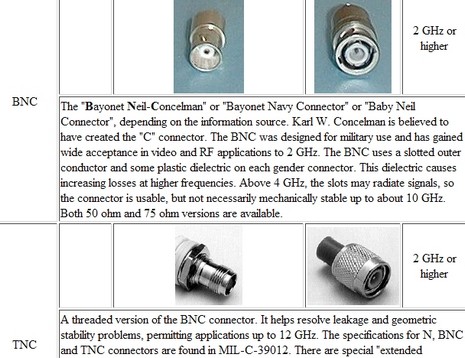Love thy coax, love thy connectors!

Let me say right off that the delightful title above—antenna cables and connectors really are important to performance—is stolen whole from a first class essay on antenna cabling written by Jason Reilly. And the illustration is cut from another useful coax connector page by Edward Kuester. I don’t want to be an expert on such matters, but anyone who fools much with VHF, GPS, AIS, TV/FM, WiFi, and cellular antennas runs into all sorts of semi-standard connectors, and often the need to transition from one to another. The links above are great for the nomenclature, intent, and limitations of the various types, but I don’t think I’ve yet found the best sources for all the bits and pieces I could use in the lab, and you might need on your boat.
I’ve bought antenna hardware at Radio Shack, Universal Radio, and my local wholesale marine outlet (which stocks the Shakespeare solderless connectors I like, though I’m not convinced they are quite as good as soldered). Maybe someone out there in Panbo world can lead me to connector heaven?
And lest anyone think this a dull subject, don’t forget that there’s sex involved, as noted by Professor Kuester:
One day a number of years back, my daughter (who was about 8 years old at the time, if memory serves) was in the lab with me while I was working at the network analyzer with one of the grad students. She overheard our conversation, peppered as it was with the terms “male connector” and “female connector”. After we were done, she asked me why the connectors were named that way. Well, this was a conversation I had expected to have in somewhat different circumstances, but I gave her a quick summary of the “how-babies-get-made” story, followed by the analogy that is implied by the connector terminology. She thought about it for a few moments when I was done, and then said, “Daddy, that’s just weird.” It’s hard to argue with that.














And of equal importance is the cable to which they are attached. I’ve found this site very useful, be sure to scroll down to the interactive calculator.
http://www.ocarc.ca/coax.htm
As pointed out in the articles, frequency is a big factor in connector selection. It is also a big factor in cable selection as cable loss for a SSB antenna lead at 25Mhz is much different than the cable loss for cellular at 900Mhz/1800MHz and WiFI at 2.5GHz
Ben;
I’ve had many positive experiences with The RF Connection.
http://www.therfc.com/
I really like their crimp-on TNC connectors for RG58 (and better yet, LMR195). I wish more manufacturers would go with TNC instead of UHF and BNC…
John Gass likes Tessco:
http://tinyurl.com/6hbnrm
Alan Spicer weighs in, via Plaxo:
> I don’t want to be an expert on such matters
* I do! Nice article. I would have added Mini-UHF used on some cellular amplifiers, and SMA and RP-SMA and a little bit more of talk on the loss that occurs on connectors and coax cables. There are online calculators, often by the cable or connector manufacturers, that can show the loss by lenght of cable and frequency. I have one spread sheet that figures for 802.11b WiFi by length of LMR 400 cable and with certain expected connectors in the line. One company I deal with seems to have very low insertion-loss coax connectors, which is nice.
Anyway it’s a good topic for articles… and for discussion. And yachts should definately know at least enough to make sure that their Electronics or Communications/Computer Tech is looking out for them in this regard. Antennas placement is often a trade off to get a clear antenna view (e.g. omni antennas) and decent height, along with not too much loss in cable and connectors. Some compensation can be made with amplifiers, where applicable.
Alan Spicer
http://www.marinetelecom.net
Hyperlink Technologies (now an L-Com companie) makes and sells good coax and connector stuff, as well as antennas for WiFi. Please keep in mind though that a lot of stuff on there is intended for professional installers. You wouldn’t want to throw up an antenna and a WiFi Power Amp without knowing the FCC Rules about this and doing your power – gains and losses calculations. You still might not be legal even if you do calculations. Just a heads up on that.
The also have tools for installing your own connectors on coax cables. They also seem to have pretty good insertion low-loss coax adaptors which are often needed to mangle old antennas and cables onto newer gear. Example you had a TNC on cellular before now you need to do SMA or RP-SMA. They have coax adaptors and radio pigtail cables. And they’ll also take custom length orders.